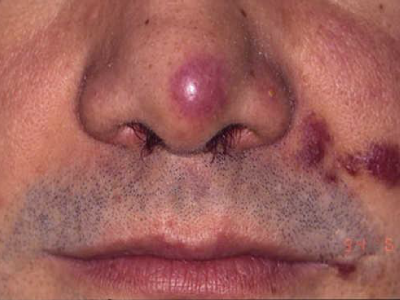What Does Kaposi Sarcoma Look Like?
Reviewed by: HU Medical Review Board | Last reviewed: May 2017. | Last updated: August 2022
Kaposi sarcoma skin cancer (KS) develops when the cells lining the blood and lymph vessels grow in an uncontrolled way. KS is rare in the United States and strongly associated with HIV infection.
The typical appearance of KS is described below. It can be hard to identify a lesion correctly on your own. If you notice changes in your skin, discuss them with your primary care provider or dermatologist.
Where does Kaposi sarcoma develop?
KS tumors, also called lesions, may develop on skin, mucous membranes, or internal organs. The number of lesions depends on the type of KS. People with classic KS may only have one lesion on the ankle or foot.1 People with AIDS-related KS may have multiple, widespread lesions.1
Skin lesions are most common on the face or legs.2 Lesions can form in the mucous membranes that line the mouth, nose, throat, and eyelids.2 Lesions may develop on internal organs, including the lungs, liver, spleen, and digestive tract.1,2
What does Kaposi sarcoma look like?

KS lesions may be flat (patches or macules), raised (plaques or papules), or bumpy (nodules).2,3 They are usually red, purple, or brown. Early on, these lesions are typically painless. However, they may develop painful sores (ulceration).
Other signs & symptoms of Kaposi sarcoma
When you first notice a lesion, you may not have any other symptoms.1 The lesions may be painless. They do not itch.
As the lesions grow, they may begin to cause symptoms. Lesions on the groin or legs block the flow of fluid out of the legs. This can lead to painful swelling.2,4 You may experience sores due to skin break down. Lesions in the digestive tract can cause internal bleeding. Signs of gastrointestinal bleeding are black or tarry stool. Abdominal pain and diarrhea are other signs of gastrointestinal lesions. If lesions develop in the lungs, you may have shortness of breath or you may cough up blood.
Similar skin conditions
There are many different types of blood vessel tumors. These tumors may have a similar appearance as KS lesions.
Other conditions that look similar to Kaposi sarcoma skin cancer are:5
- Hematoma, which a large clot of blood that accumulates outside of a blood vessel in tissue.
- Dermatofibroma, which is a harmless skin growth.
- Purpura, which are spots caused by bleeding from the small blood vessels under the skin.